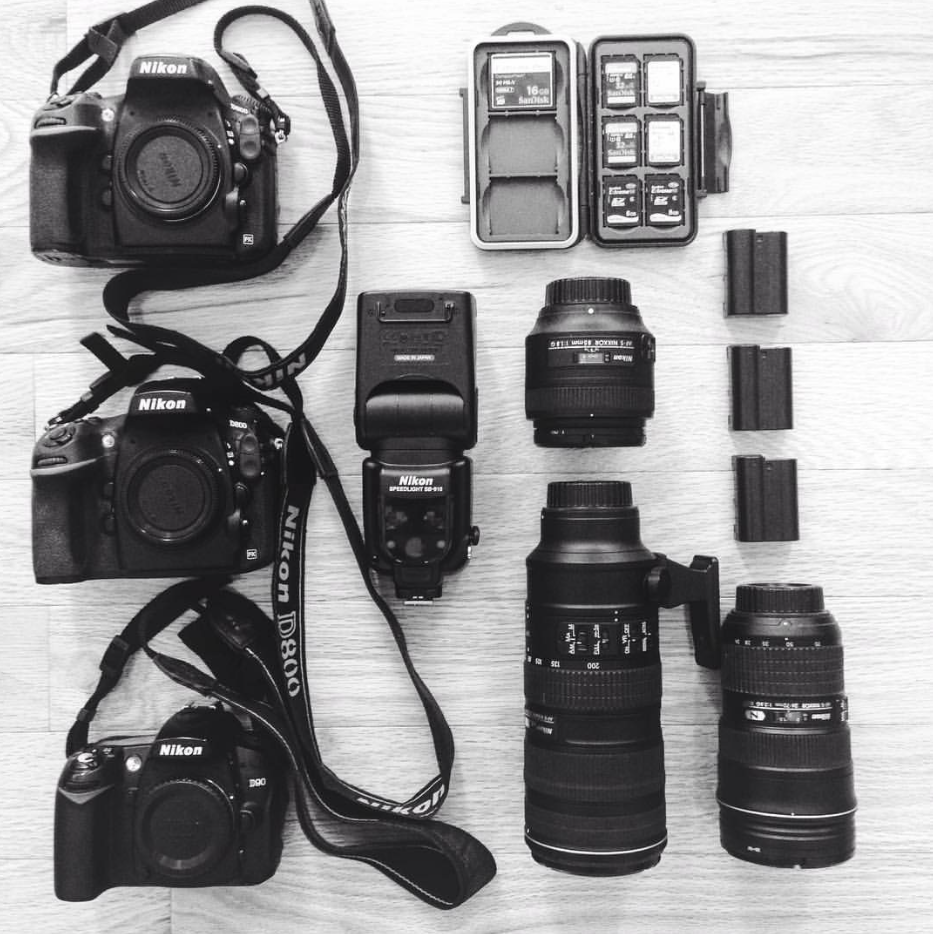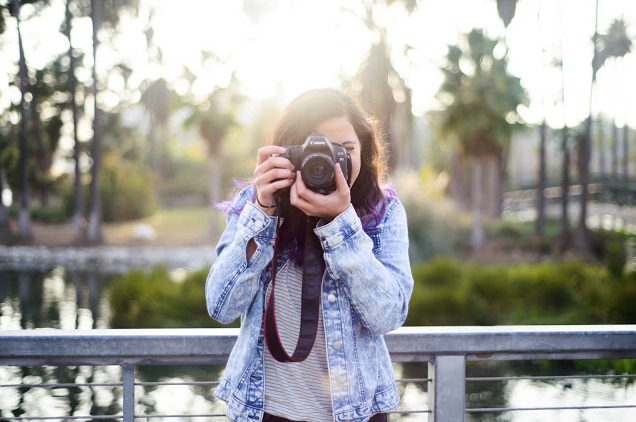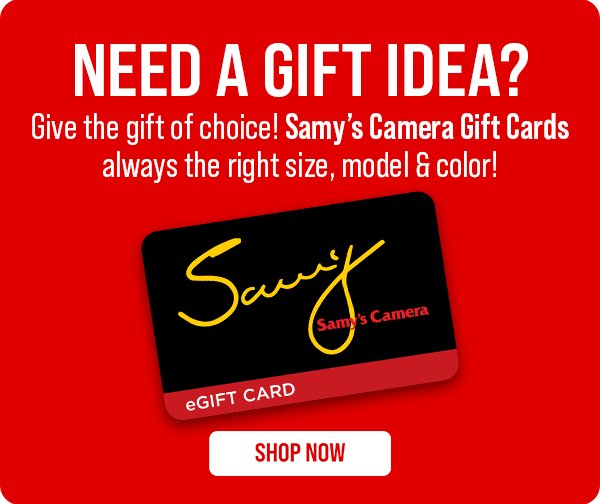“What’s in your wedding arsenal?” is a question I get asked frequently. I’ve also seen countless of my photographer peers answer this question on their websites. The common consensus is that every photographer has their own shooting style and own favorite gear they bring on a wedding day shoot. However, there are some commonalities and trends that I’ll break down for you.
[caption id="attachment_3380" align="alignnone" width="640"] Credit: Kylie Nicholson[/caption]
Credit: Kylie Nicholson[/caption]
 Credit: Kylie Nicholson[/caption]
The zoom lens camp values versatility without sacrificing quality. The zoom lens camp can shoot an entire wedding with two lenses: a 24-70 f 2.8 and a 70-200 f 2.8. These two lenses, along with a full-frame body, are what I purchased as my “wedding arsenal” before I started shooting weddings. They offer a lot of flexibility (you can shoot anything with these two lenses) and minimize the need to change lenses. The downside of this option is that you’re limited to a maximum aperture of 2.8, which can be too high for more fine-art photographers. It really depends on your shooting style. The 70-200 is also a beast and can be a lot to tote around. The prime camp has a much lighter camera bag.
There are many photographers who mix between these two camps, shooting primes for portraits and zoom for the ceremony. I’m among this group. When I first wrote this post about a month ago, I primarily used my 24-70 f 2.8, my 70-200 f 2.8, and my 85mm (because I’m obsessed with how it handles light for portraits!). However, now I’m loving my 35mm, my 50mm, and then my two zoom lenses for the ceremony.
LIGHTING
It’s difficult if not impossible to get away with an entire wedding without using artificial light. I recommend having at least two OCFs (off-camera flashes, I use Nikon SB-910s) and diffusers. If you’re indoors you can easily bounce flash off of a wall or ceiling. If you’re outside at night, you’ll need a diffuser or softbox attachment to soften the light. Even if you bill yourself as a natural light photographer, you need to know how to work with flashes, because you never know the kind of lighting situation you might find yourself in.
Depending on the venue (indoor or outdoor) and lighting, you may be able to get away with shooting an outdoor wedding entirely without flash. I’ve photographed outdoor receptions with a lot of twinkle and other lights using minimal flash. If you have an artsy style, you can sometimes get away with shooting without flash and a high ISO, and embracing the grain.
Credit: Kylie Nicholson[/caption]
The zoom lens camp values versatility without sacrificing quality. The zoom lens camp can shoot an entire wedding with two lenses: a 24-70 f 2.8 and a 70-200 f 2.8. These two lenses, along with a full-frame body, are what I purchased as my “wedding arsenal” before I started shooting weddings. They offer a lot of flexibility (you can shoot anything with these two lenses) and minimize the need to change lenses. The downside of this option is that you’re limited to a maximum aperture of 2.8, which can be too high for more fine-art photographers. It really depends on your shooting style. The 70-200 is also a beast and can be a lot to tote around. The prime camp has a much lighter camera bag.
There are many photographers who mix between these two camps, shooting primes for portraits and zoom for the ceremony. I’m among this group. When I first wrote this post about a month ago, I primarily used my 24-70 f 2.8, my 70-200 f 2.8, and my 85mm (because I’m obsessed with how it handles light for portraits!). However, now I’m loving my 35mm, my 50mm, and then my two zoom lenses for the ceremony.
LIGHTING
It’s difficult if not impossible to get away with an entire wedding without using artificial light. I recommend having at least two OCFs (off-camera flashes, I use Nikon SB-910s) and diffusers. If you’re indoors you can easily bounce flash off of a wall or ceiling. If you’re outside at night, you’ll need a diffuser or softbox attachment to soften the light. Even if you bill yourself as a natural light photographer, you need to know how to work with flashes, because you never know the kind of lighting situation you might find yourself in.
Depending on the venue (indoor or outdoor) and lighting, you may be able to get away with shooting an outdoor wedding entirely without flash. I’ve photographed outdoor receptions with a lot of twinkle and other lights using minimal flash. If you have an artsy style, you can sometimes get away with shooting without flash and a high ISO, and embracing the grain.
 Credit: Kylie Nicholson[/caption]
Credit: Kylie Nicholson[/caption]
CAMERA BODY
To shoot weddings professionally, you’ll pretty much need a full-frame camera body. Most of the greats of the wedding photography business use either Nikon or Canon, but there is a minority that mix in the others. You’ll also need a back-up body. There’s nothing worse than having a camera body malfunction on a wedding day, and with no back-up body- you’re rendered useless. As the photographer it’s your responsibility to ensure that you have enough gear to do your job no matter what curveballs may be thrown. I actually shoot with two full-frame cameras on me at a wedding: one with a zoom lens and one with a wide angle lens (normally one with a 24-70 mm lens and another with a 70-200 mm lens). I do this so that I can be mobile, agile and avoid needing to change lenses endlessly on the wedding day. By keeping one of each type on lens on each body and both bodies on me at all times (one on each shoulder), I can simply switch between bodies. This is especially useful (and vital in my work) during the ceremony when things happen at lightning speed. Positioned mid-aisle, I’ll often use my wide angle to capture the bride walking down the aisle towards me, then quickly switch to my zoom lens to capture the groom’s face as soon as the bride passes me. Many hands make for light work, as do many camera bodiesLENSES
This is where photographers differ. There’s pretty much two camps here: the prime lens camp and the zoom lens camp. The prime lens camp treasures the non-zooming, fixed focal length and glass quality of prime lenses. A prime lens wedding photographer will often have a 35mm, a 50mm, and an 85mm as their three lenses for the day. The benefit to shooting with prime lenses is a wider maximum aperture (1.8, 1.4, or 1.2 depending on the lens), and sometimes better glass quality. The downside is the lack of zoom, which can be difficult when things move quickly and a widely different focal length is needed than the one you currently have on your camera. This can be controlled by the multi-body technique I described in the body section. [caption id="attachment_3377" align="alignnone" width="636"] Credit: Kylie Nicholson[/caption]
The zoom lens camp values versatility without sacrificing quality. The zoom lens camp can shoot an entire wedding with two lenses: a 24-70 f 2.8 and a 70-200 f 2.8. These two lenses, along with a full-frame body, are what I purchased as my “wedding arsenal” before I started shooting weddings. They offer a lot of flexibility (you can shoot anything with these two lenses) and minimize the need to change lenses. The downside of this option is that you’re limited to a maximum aperture of 2.8, which can be too high for more fine-art photographers. It really depends on your shooting style. The 70-200 is also a beast and can be a lot to tote around. The prime camp has a much lighter camera bag.
There are many photographers who mix between these two camps, shooting primes for portraits and zoom for the ceremony. I’m among this group. When I first wrote this post about a month ago, I primarily used my 24-70 f 2.8, my 70-200 f 2.8, and my 85mm (because I’m obsessed with how it handles light for portraits!). However, now I’m loving my 35mm, my 50mm, and then my two zoom lenses for the ceremony.
LIGHTING
It’s difficult if not impossible to get away with an entire wedding without using artificial light. I recommend having at least two OCFs (off-camera flashes, I use Nikon SB-910s) and diffusers. If you’re indoors you can easily bounce flash off of a wall or ceiling. If you’re outside at night, you’ll need a diffuser or softbox attachment to soften the light. Even if you bill yourself as a natural light photographer, you need to know how to work with flashes, because you never know the kind of lighting situation you might find yourself in.
Depending on the venue (indoor or outdoor) and lighting, you may be able to get away with shooting an outdoor wedding entirely without flash. I’ve photographed outdoor receptions with a lot of twinkle and other lights using minimal flash. If you have an artsy style, you can sometimes get away with shooting without flash and a high ISO, and embracing the grain.
Credit: Kylie Nicholson[/caption]
The zoom lens camp values versatility without sacrificing quality. The zoom lens camp can shoot an entire wedding with two lenses: a 24-70 f 2.8 and a 70-200 f 2.8. These two lenses, along with a full-frame body, are what I purchased as my “wedding arsenal” before I started shooting weddings. They offer a lot of flexibility (you can shoot anything with these two lenses) and minimize the need to change lenses. The downside of this option is that you’re limited to a maximum aperture of 2.8, which can be too high for more fine-art photographers. It really depends on your shooting style. The 70-200 is also a beast and can be a lot to tote around. The prime camp has a much lighter camera bag.
There are many photographers who mix between these two camps, shooting primes for portraits and zoom for the ceremony. I’m among this group. When I first wrote this post about a month ago, I primarily used my 24-70 f 2.8, my 70-200 f 2.8, and my 85mm (because I’m obsessed with how it handles light for portraits!). However, now I’m loving my 35mm, my 50mm, and then my two zoom lenses for the ceremony.
LIGHTING
It’s difficult if not impossible to get away with an entire wedding without using artificial light. I recommend having at least two OCFs (off-camera flashes, I use Nikon SB-910s) and diffusers. If you’re indoors you can easily bounce flash off of a wall or ceiling. If you’re outside at night, you’ll need a diffuser or softbox attachment to soften the light. Even if you bill yourself as a natural light photographer, you need to know how to work with flashes, because you never know the kind of lighting situation you might find yourself in.
Depending on the venue (indoor or outdoor) and lighting, you may be able to get away with shooting an outdoor wedding entirely without flash. I’ve photographed outdoor receptions with a lot of twinkle and other lights using minimal flash. If you have an artsy style, you can sometimes get away with shooting without flash and a high ISO, and embracing the grain.






